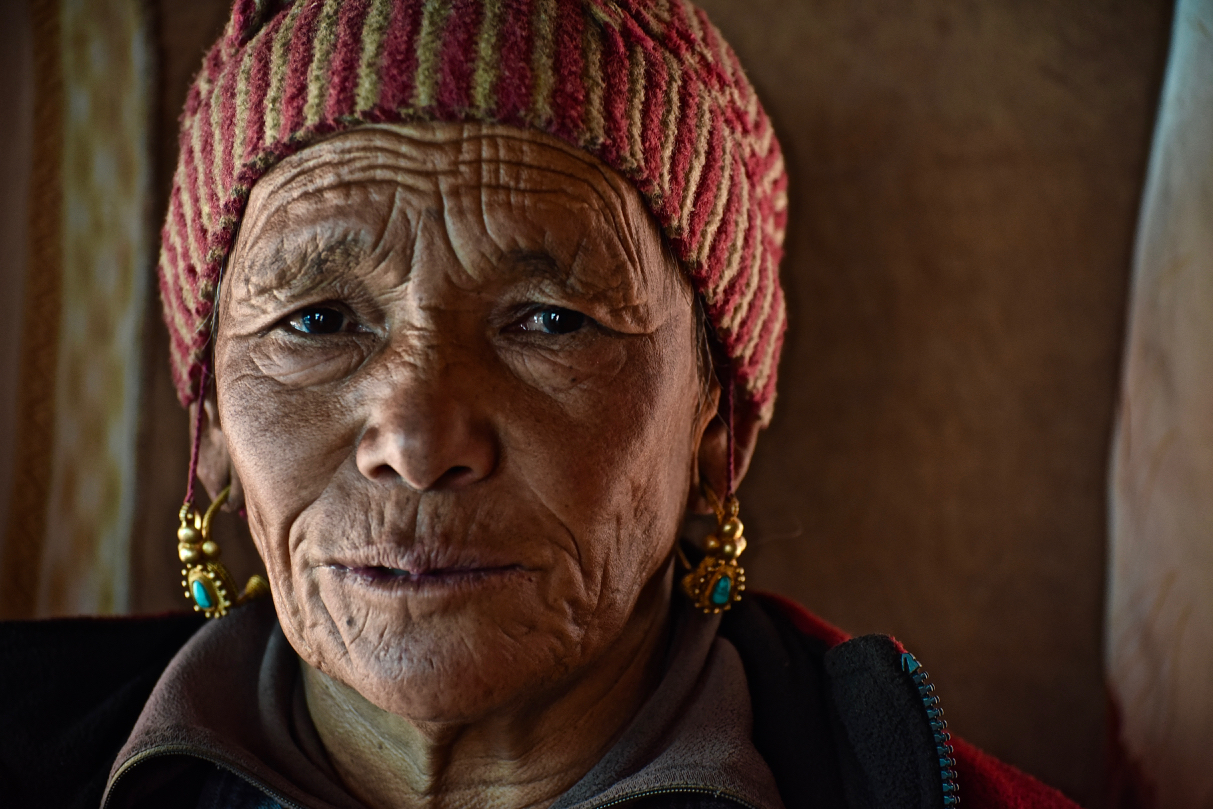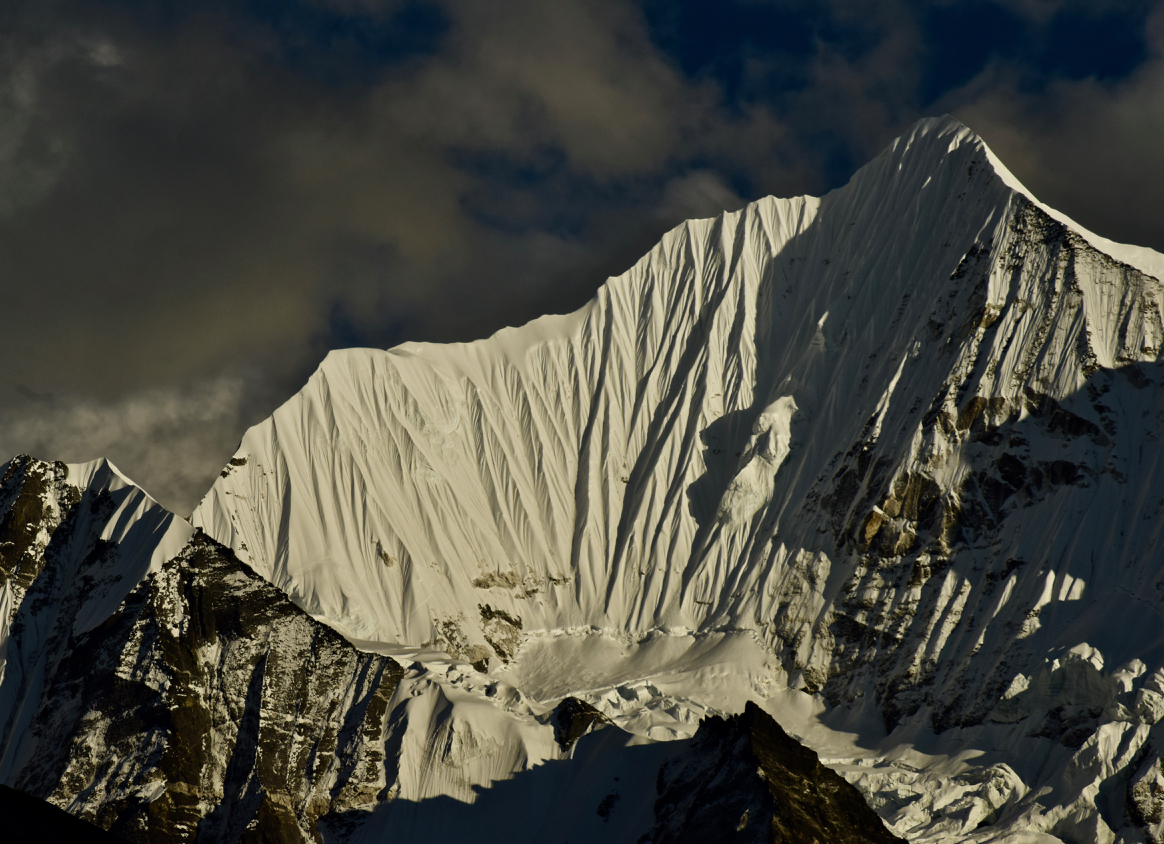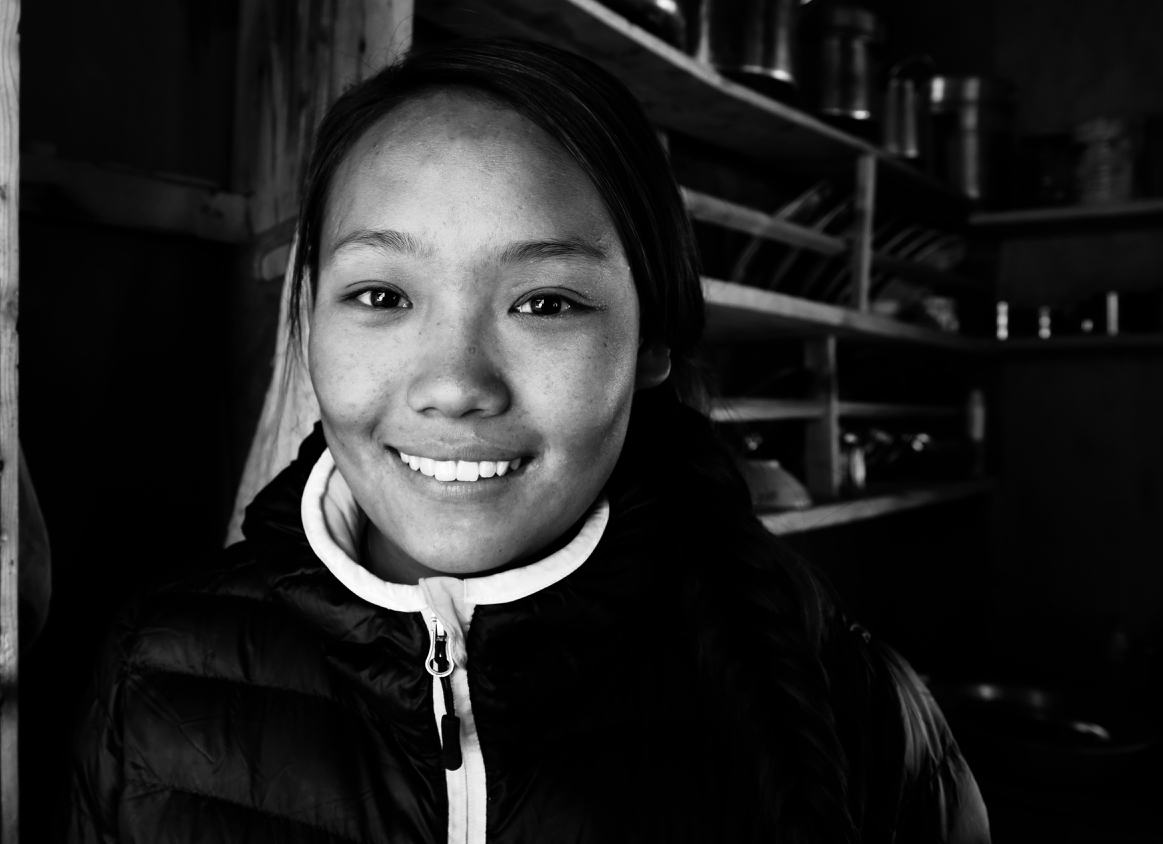Langtang, the land called “Ox’s land” is grassland valley and ‘was’ a village…one that has been destroyed, reset eastward and rebuilt (if such a thing is possible). It lives again not far from a swath of rubble, stone, and line strokes that descend from the north. An avalanche obliterated the village with inhabitants, travellers, and animals alike being wiped out. The ‘new’ Langtang sits just east and higher than the swath of stone that covers what once was. Crossing the rubble that was once a village along a dirt pathway as light turns blue mountain cold comes with the knowledge of what lies below our feet.

The trance like spectre always rides our horizons – ever upwards. Mountains shade and shape Langtang’s valley.
Mingmar has continued his foraging for anything of value in the soil. And, there is much in that soil! He has secured us entry into a nomadic shelter to sip some of the rich ‘sho’ (yak yoghurt) that carries a tang of sweet-sour beauty. Mingmar laments fields that lie fallow and show little signs of life or care and he speaks with raging directness and clarity. He laments too that locals would have once been more self-sufficient and known what to grow and when and been proud of their self-sufficiency rather than proud of an imported item.

Langtang habits are the habits of the Himalayas. One such is a draw to me – the making of the local ‘arra’ or whisky.
Now, he repeats what many have said throughout the Himalayas, that too much is imported and depended upon; that too much that could be produced locally is brought in on backs wrapped in plastics that will have to find their way out of the mountains once again. He fears the loss of so much wisdom that contributed to an autonomy of sorts. Mingmar and his rants are things that delight in an ominous way and he cannot be deterred from them.

Guesthouse owner Pasang. Gravelly voice, perpetually in motion and like so many in the valley, one who lost many family and friends in the avalanche of 2015.
He has been a guide for decades and is one of the rare ones that can identify almost every dialect, herb, and nugget of cultural significance of a region and he is one who cares not for any overly polite demonstrations. He knows the glaciers but not by the name any researchers have bestowed…he knows the glaciers by their old hereditary Tibetan names. He speaks from the blood, to the any and all and to the air and winds as much as to us. He easily swings into his speeches without any prompting knowing they are welcome and real.

When not foraging, cooking, or engaged in one of his long monologues, he pays tribute to his beliefs and deities. He does so in as passionate a manner as he does in every single other element in his life.
Our interviews begin in a more formal way in Langtang village, with our questions being put to different generations. Questions of what has changed and evolved or disappeared and how the community and environment interaction has morphed are the focus areas. Elder Dawa and his niece the younger Dawa (Kandro) speak similarly and of common threads – despite their age difference of almost four decades. Her wonderful witty mother Maya (with a penchant for sitting on floors with a cup of tea) in bucket loads shares how the mountains are simply home and that with any home one has to care for it and live with it. It is all, she believes, connected. All things, times, and spaces are interconnected for her.

Maya, who entranced with humour, directness, and spontaneously walking out of rooms mid-sentence. An absolute gem of wisdom.
Many here speak of the need to see concept of change in a larger context than simply the present tense. The elder Dawa had lost close members of his family to the avalanche which piled downwards from the Langtang Lirung. He urges and pleads for the need to continue to revere Nature and the peaks, despite the threat that lurks above. He also mirrors much of Mingmar’s thoughts on how so much ‘earth-know-how’ has disappeared because of the ability of youth to access farther-away worlds of modern life. A glacier was once a sacred thing to locals. Now, it is something that is sometimes not even acknowledged.

Much of Maya’s wisdom came out when sipping straight black tea. I was content with any time at all around this mother of the mountains.
Part of my own thought process in all of this is how much more linear and non-agenda oriented are the thoughts of these who live within the water towers that feed Asia. It is visceral and tangible in the most simple manner of observation. It is that simplest and most dragged out and tortured of things these days: fact. It is fact for the perceptions of those who spend most of every day within the eye of such diminishing and fragile elements.

The two Dawa’s take in a memorial for those lost in the 2015 avalanche. They know only too well the mountains’ force being from the Kunlun region of Nepal.
“We cannot change too much of what is there, but we can manage what we see and how we move forward”, Uncle Dawa says at one point over a tea. As with so much in my own frames of life, tea is a conduit and facilitator. It is a fluid that soothes, and stimulates.

A beautiful moment mid-conversation with Uncle Dawa in the foreground and Pasang both listening to others within our room.
To our east the land continues to rise towards Kyanjin Gomba. Most families in this upper quadrant of the valley are linked to cousins’, parents’, or friends’ homes somewhere along the valley. As much as the paths are conduits for trekkers, they are meeting places for locals and pathways for their own journeys. Still the valley is bound by those that reside within and with the news that is transported by word of mouth. Connections here are pleasingly informal still.

Looking east towards Dorje Lhakpa
Snow drives down on us as we approach Kyanjin and then it ebbs, treating us to a sky of grey and silver popping blurs. Temperatures and wind levels both drop. The two porters Dawa, power ahead with their loads moving fast to arrive and settle and install themselves with a cup of tea. Their pace is like so many of the porters and mountain carriers. They prefer frequent but brief breaks making excellent time with the kind of intuitive knowledge of their strengths and limitations.

Always, there is tea brewing. Here Kersang of Mountain View Guesthouse in Kyanjin does the honours…with some gusto!
Kyanjin village is a pocket of bright coloured guesthouses of tin and stone that is parked at north of the valley; where mountains rise. Mountain View Guesthouse is where we will stash kit, sip tea and treat as a home. Sonam and Kersang run the collection of beds from their kitchen, which like every single human space in the valley, is the heart of the home. Fires burn in stoves with dung still the preferred method of fuelling.

Kyanjin’s western edge
Sonam is one of those sturdy witnesses of his surroundings who smiles much but worries about the environment in a way that many who live with Nature’s every mood do. He has watched ice and snow ebb, and with it he has watched as water channels of melt water disappear. Glacial melt water flows from the north down into the valley and the equally vital Spring water which finds its sources deep within the stone hollows, follows a different channels further south. It is the Spring water that he worries most about simply because the sources are not seen. “Those mountains are losing ice and snow every year. I can see their change. Our water is the water of cities too”.

Young Dawa, already with mountain wisdom imbued in her shares her own generations views on the environment and her Himalayan home.
His wife Kersang is a body of motion as she prepares tea, food…and more tea each hour. Butter tea in her household is made in the early morning with an optional addition of Snow Rhododendron petals, which fortifies the already solid brew of fuel.

Kyanjin with a cold front moving in
My diminishing hunk of Puerh starts the mornings before any of the potent butter tea makes its way into my system. We will head up into the basin that forms a catchment for both the Lirung and the Kyanjin glaciers in two days time. It will be the place where the words and observations of those who live amidst meet up with the ice and water bodies that morph and ebb.

Always, everything is started, stated and completed with tea. From left: Mingmar, Dawa, and Pasang with some morning strong brew.

About JeffFuchs
Bio
Having lived for most of the past decade in Asia, Fuchs’ work has centered on indigenous mountain cultures, oral histories with an obsessive interest in tea. His photos and stories have appeared on three continents in award-winning publications Kyoto Journal, TRVL, and Outpost Magazine, as well as The Spanish Expedition Society, The Earth, Silkroad Foundation, The China Post Newspaper, The Toronto Star, The South China Morning Post and Traveler amongst others. Various pieces of his work are part of private collections in Europe, North America and Asia and he serves as the Asian Editor at Large for Canada’s award-winning Outpost magazine.
Fuchs is the Wild China Explorer of the Year for 2011 for sustainable exploration of the Himalayan Trade Routes. He recently completed a month long expedition a previously undocumented ancient nomadic salt route at 4,000 metres becoming the first westerner to travel the Tsa’lam ‘salt road’ through Qinghai.
Fuchs has written on indigenous perspectives for UNESCO, and has having consulted for National Geographic. Fuchs is a member of the fabled Explorers Club, which supports sustainable exploration and research.
Jeff has worked with schools and universities, giving talks on both the importance of oral traditions, tea and mountain cultures. He has spoken to the prestigious Spanish Geographic Society in Madrid on culture and trade through the Himalayas and his sold out talk at the Museum of Nature in Canada focused on the enduring importance of oral narratives and the Himalayan trade routes.
His recently released book ‘The Ancient Tea Horse Road’ (Penguin-Viking Publishers) details his 8-month groundbreaking journey traveling and chronicling one of the world’s great trade routes, The Tea Horse Road. Fuchs is the first westerner to have completed the entire route stretching almost six thousand kilometers through the Himalayas a dozen cultures.
He makes his home in ‘Shangrila’, northwestern Yunnan upon the eastern extension of the Himalayan range where tea and mountains abound; and where he leads expeditions the award winning ‘Tea Horse Road Journey’ with Wild China along portions of the Ancient Tea Horse Road.
To keep fueled up for life Fuchs co-founded JalamTeas which keeps him deep in the green while high in the hills.














